Actions speak louder than words…
A Bergoglian Corpus Christi
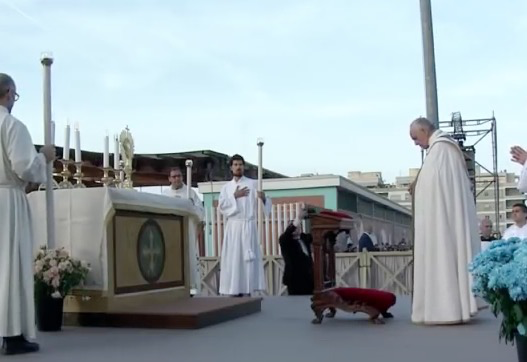
Every year the Feast of Corpus Christi (Body of Christ) solemnly commemorates our Lord’s institution of the Holy Eucharist at the Last Supper the night before His Crucifixion. When Christ spoke the words “This is My Body… This is My Blood” (Mt 26:26,28), He transubstantiated bread and wine into His very own Body, Blood, Soul, and Divinity — to be our perpetual Sacrifice “unto remission of sins” (Mt 26:28) and heavenly Food (see Jn 6:51-52) to be with us forever (cf. Mt 28:20; Jn 14:18). Thus the Sacred Liturgy celebrates the Most Holy Sacrament of the Altar as Sacrifice (Holy Mass), as Meal (Holy Communion), and as Adorable Presence in the Tabernacle. In the liturgical calender, Corpus Christi is always celebrated on the Thursday after Trinity Sunday, but in countries where the feast is not a holyday of obligation, the solemnity is observed on the following Sunday.
Although in recent decades Corpus Christi, which in the Novus Ordo liturgy is vernacularly known as the Feast of the Body and Blood of Christ, was celebrated in Rome on the Thursday itself, this year “Pope” Francis chose to commemorate it on the Sunday following (June 3) and not in Rome but in nearby Ostia.
From the beginning of his fake pontificate, Francis has had a “difficult relationship” with Corpus Christi, and his disturbing actions and omissions have always been more or less the same: He refuses to kneel before the ostensible Blessed Sacrament even on its most solemn feast of the year, even though a comfortable kneeler is conspicuously provided for him every time. In addition, he outsources the solemn Eucharistic procession with the monstrance to some other cleric(s). So too this year. The entire spectacle was broadcast live by Vatican Media, and you can watch a recording of it here:
By contrast, you can get a glimpse of a real papal Corpus Christi procession with Pope Pius XII here:
One may certainly say that at 81 years of age, Francis just isn’t fit enough anymore to be processing through the streets on foot carrying a monstrance — that’s fair enough. However, Francis wouldn’t be walking nor carrying the “Blessed Sacrament” anyway since, as prior years show, the monstrance is always placed on a moving vehicle and the “Pope” is supposed to kneel right behind it, and yet Francis didn’t do that either (in 2013, he did take part in the procession on foot with the people while two “deacons” accompanied the monstrance on their knees — see video here).
Here are some photos of the “papal” Corpus Christi processions from prior years, in chronological order:
2013 – Francis walks with the people
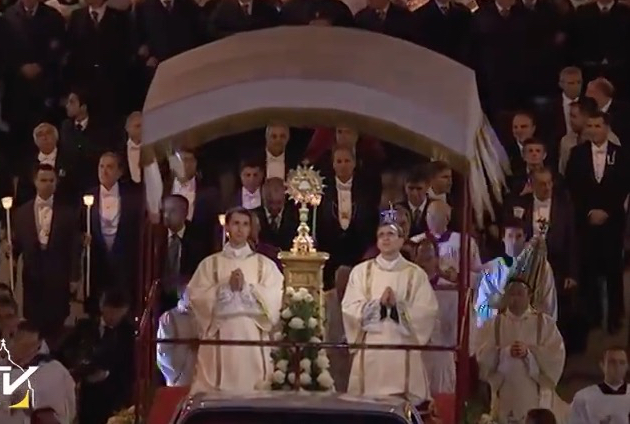
2014 – Francis is nowhere to be found
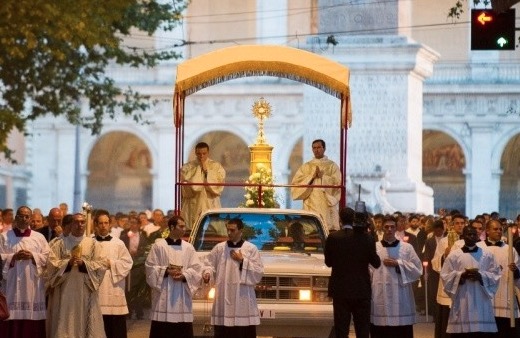
2015 – Francis is nowhere to be found
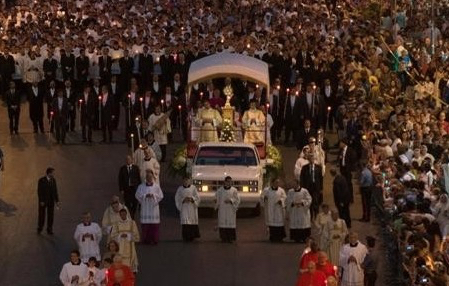
2016 – Francis is nowhere to be found
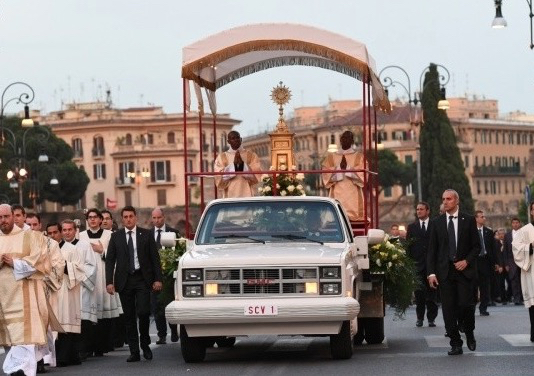
2017 – Francis is nowhere to be found
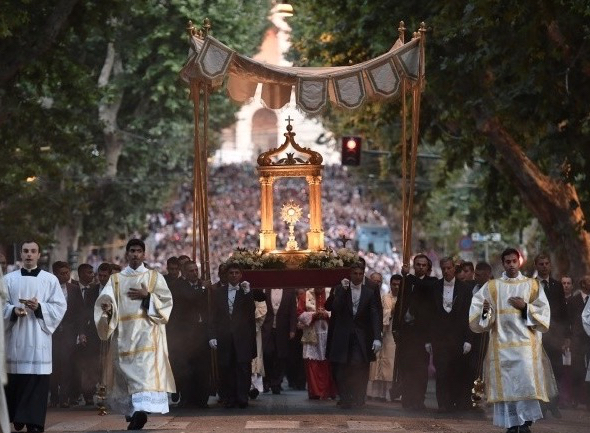
Some of these images are © Osservatore Romano
Why, then, should this year have been any different?
As we have observed on this blog several times before, the Bergoglian knees always give out (with some very few exceptions) whenever the “Blessed Sacrament” is involved. At other times, they work just fine. So, for example, he kneels before Protestants who offer him a “blessing” (see 40:53 mark here); he kneels before and lauds Anglican pseudo-martyrs; he kneels to make a public spectacle of his “humility” by flaunting his going to confession in St. Peter’s (see how quickly he can kneel on his own at 0:19 here); he endorses “doing theology while kneeling”; he says we should all “kneel before the poor”; and, of course, he is happy to kneel the whole time while washing the feet of twelve people, including infidels, on Holy Thursday. We have summarized this double standard in the following meme:
In addition to Francis’ actions, however, we also have his words to deal with.
In this year’s Corpus Christi sermon, the Jesuit antipope threw a few crumbs to the conservatives, going so far as to exhort people to “rediscover Eucharistic adoration in our communities”. For a Jesuit “ordained” in 1969, that really is remarkable. However, it was a given that we were also going to hear something about, you know, the poor and the marginalized, with a possible veiled reference to migrants:
How many persons lack dignified housing or food to eat! All of us know people who are lonely, troubled and in need: they are abandoned tabernacles. We, who receive from Jesus our own room and board, are here to prepare a place and a meal for these, our brothers and sisters in need. Jesus became bread broken for our sake; in turn, he asks us to give ourselves to others, to live no longer for ourselves but for one another. In this way, we live “eucharistically”, pouring out upon the world the love we draw from the Lord’s flesh. The Eucharist is translated into life when we pass beyond ourselves to those all around us.
The Gospel tells us that the disciples prepared for the meal after they “set out and went to the city” (v. 16). The Lord calls us also today to prepare for his coming not by keeping our distance but by entering our cities. That includes this city, whose very name – Ostia – means entrance, doorway. Lord, how many doors do you want us to open for you here? How many gates do you call us to unbar, how many walls must we tear down? Jesus wants the walls of indifference and silent collusion to be breached, iron bars of oppression and arrogance torn asunder, and paths cleared for justice, civility and legality. The vast beachfront of this city speaks to us of how beautiful it is to open our hearts and to set out in new directions in life. But this requires loosening the knots that keep us bound to the moorings of fear and depression. The Eucharist invites to let ourselves be carried along by the wave of Jesus, to not remain grounded on the beach in the hope that something may come along, but to cast into the deep, free, courageous and united.
(Antipope Francis, Homily for Corpus Christi, Vatican.va, June 3, 2018; italics given.)
Instead of just talking about how we need to provide food and shelter for our brothers and sisters, it would be great if at some point he could also mention that what is infinitely more important than these natural considerations is the supernatural life of the soul. For unless our brothers and sisters convert to Jesus Christ and His Holy Catholic Church, all the food in the world will ultimately only bring them eternal death: “Labour not for the meat which perisheth, but for that which endureth unto life everlasting, which the Son of man will give you. For him hath God, the Father, sealed” (Jn 6:27).
Francis’ fellow-Jesuit, the abominable LGBT promoter and professional hellboy “Fr.” James Martin, also had something to say with regard to Corpus Christi. On Twitter, he posted the following message on June 3 (click image to enlarge):
For those who may not be able to see the screenshot, this is what Martin says: “On this Feast of #CorpusChristi, reverence the Body of Christ in the Eucharist, and reverence him in the bodies of those who suffer today: the hungry refugee, the beaten migrant, the bullied gay youth, the ailing elderly person, the endangered unborn child. This is Christ’s Body.” (The link to the actual tweet can be accessed here.)
Perhaps he thought that by including a reference to “the endangered unborn child” he was going to impress a few conservatives, but here too Mr. Martin fails: Although all unborn children are innocent of any personal sin and deserving of all protection, they are not part of the Body of Christ, for we are not children of God by nature but by grace (cf. Eph 2:1-9), having been conceived in original sin (cf. Ps 50:7); and children below the age of reason can only receive God’s sanctifying grace through the sacrament of baptism: “An act of love [=perfect contrition] is sufficient for the adult to obtain sanctifying grace and to supply the lack of baptism; to the still unborn or newly born this way is not open” (Pope Pius XII, Address to Midwives, Oct. 29, 1951). Thus, the preborn are not part of the Body of Christ. This goes to show how much removed this “Catholic priest” is from true Roman Catholic teaching. Like his Argentine boss, Martin is a Naturalist — people like them do not believe in the necessity or in the gratuity of grace, and it shows.
But the more in-your-face outrage in Martin’s tweet is, of course, the equation of the Real Presence of Jesus Christ in the Most Holy Eucharist with the figurative or perhaps phenomenological presence of Christ in “these my least brethren” (Mt 25:40). This alone would have to be blasphemy, because in the Holy Eucharist alone is Christ physically and substantially present. Martin is saying that the poor, the outcast, the needy, etc. are the Body of Christ, objectively speaking — which is sheer nonsense. As always, of course, Martin couldn’t refrain from blasphemously including a sodomite in his list of the quasi-divine downtrodden: “the bullied gay youth”.
Keep in mind: This man was recently appointed by Francis to be an advisor on the Vatican’s Department for Communications.
The constant exaggeration of “these my least brethren” into a second Incarnation of Jesus Christ is a hallmark of Francis’ false theology; it allows him to promote the worship of man under the guise of worshipping God — even to the point of telling his sheeple to kneel before the poor:
-
“Pope: Christians should kneel before the Poor” (Vatican Radio)
Club Francis tries to make it seem as though this divinization of anyone who is in some way afflicted with something (and who isn’t?) were scriptural: Did not Christ identify Himself with our brothers and sisters in need? Did He not state that what we (do not) do to them we (do not) do to Him? He did indeed, but most certainly not in the exaggerated sense which Bergoglian Modernists give to these sacred words!
Looking at the full pericope in question (Matthew 25:31-46), it does not take much to understand that obviously Christ wasn’t speaking literally when He said that He was hungry, thirsty, naked, etc. Rather, Christ teaches us there that He will judge us based on our works — not only on our works but also on our works (cf. Heb 11:6; Mk 16:16; Jas 2:24). He identifies with the needy inasmuch as we (do or don’t) help them for love of Him: “For whosoever shall give you to drink a cup of water in my name, because you belong to Christ: amen I say to you, he shall not lose his reward” (Mk 9:40).
Commenting specifically on the merits of the good works mentioned in Matthew 25, the Jesuit scholar Fr. Cornelius a Lapide explains that Christ “counts them done to Himself, because they were done to the poor for love of Christ” (Great Commentary, vol. 3 [London: John Hodges, 1891], p. 138; italics added). And in the Act of Charity, we declare unto God: “I love my neighbor as myself for the love of Thee” (source).
Thus we see that Matthew 25 has nothing to do with the needy actually being the Body of Christ, which, at any rate, is the Church (see Col 1:24), not a loose conglomeration of individuals who have in some wise been rejected or mistreated by some others. Martin, Francis, and the rest of the apostate gang in Rome that falsely uses the label “Roman Catholic”, are simply trying to put the Real Presence of Christ in the Eucharist on the same level with a figurative presence of Christ in those who suffer, just as they have been doing their darndest to equate the crime of abortion with a “broken immigration system”.
Don’t be surprised if for next year’s “Corpus Christi”, Martin suggests that we build a monstrance big enough to fit a few people from every category — homeless, handicapped, terminally ill, LGBT, migrant, nonagenarian, Eskimo — since they are, as he claims, the Body of Christ. Don’t put it past him.
Lastly, let us have a look at how, when it comes to the Holy Eucharist, the words of the Novus Ordo Sect are always in stark contrast to the actions that are performed.
For example, have a look at these lofty words from “Pope” John Paul II’s long encyclical letter on the Blessed Sacrament:
The Church draws her life from the Eucharist. This truth does not simply express a daily experience of faith, but recapitulates the heart of the mystery of the Church. In a variety of ways she joyfully experiences the constant fulfilment of the promise: “Lo, I am with you always, to the close of the age” (Mt 28:20), but in the Holy Eucharist, through the changing of bread and wine into the body and blood of the Lord, she rejoices in this presence with unique intensity. Ever since Pentecost, when the Church, the People of the New Covenant, began her pilgrim journey towards her heavenly homeland, the Divine Sacrament has continued to mark the passing of her days, filling them with confident hope.
The Second Vatican Council rightly proclaimed that the Eucharistic sacrifice is “the source and summit of the Christian life” [Lumen Gentium, n. 11]. “For the most holy Eucharist contains the Church’s entire spiritual wealth: Christ himself, our passover and living bread. Through his own flesh, now made living and life-giving by the Holy Spirit, he offers life to men” [Presbyterorum Ordinis, n. 5.]. Consequently the gaze of the Church is constantly turned to her Lord, present in the Sacrament of the Altar, in which she discovers the full manifestation of his boundless love.
(Antipope John Paul II, Encyclical Ecclesia de Eucharistia, n. 1)
Ah, such sublime words! We hear about drawing life; about recapitulating the heart of the mystery of the Church; about unique intensity; about the source and summit of the Christian life; about the Church’s entire spiritual wealth; about the living and life-giving flesh of Christ; about the gaze of the Church and the full manifestation of God’s boundless love! …Are you swooning yet?
The problem is just that in spite of these beautiful words, the reality the Novus Ordo Sect offers is quite different, especially in the Western world. At the very Corpus Christi celebration of June 3 over which Francis presided, this is how “Holy Communion” was administered and received (screenshots taken from video at 1:01:34-1:01:40):
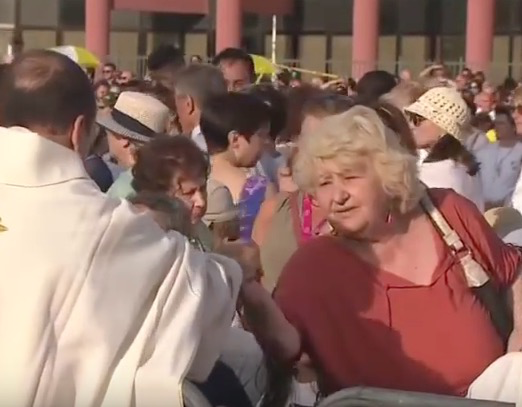
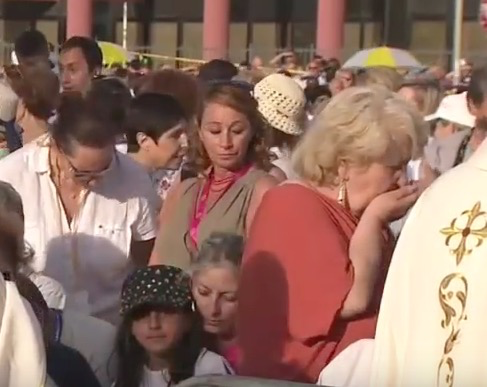
This is standard practice for an outdoor “Mass” in the Vatican II Church. The internet is full of photos and videos of the average “Catholic Mass”, what takes place there, how people are dressed and behave, and how what they supposedly believe is the Body and Blood of Christ is treated on a regular basis. Our own page on the Holy Catholic Mass vs. the Modernist Happy Meal contains many good resources in this regard.
Forget all the lofty words the Modernist prelates continually speak about the Eucharist. It is their actions that show what they really believe: They have yanked the Tabernacle off the altar so that the focus could be on man rather than on God; they have replaced the traditional Tabernacles with the most hideous boxes they knew to come up with; they have replaced the traditional altars with pitiful tables lest people think of Mass as a Sacrifice rather than a meal; and so on and so forth. It is those things that people absorb deeply into their souls because they are tangible things they see and experience every time, belying any words to the contrary they may occasionally hear.
This is why the Modernist revolution has been so successful. Not because Vatican II said this or that — nobody reads Vatican II — but because the so-called “New Mass” and the new church buildings have destroyed the faith of hundreds of millions and poisoned their souls. And yet, the very “authorities” that are responsible for the near-total collapse of all that is true and sacred in the Catholic religion, are the same people who on a day like Corpus Christi try to tell you about how the Holy Eucharist is the source and summit of the Christian life, contains the Church’s entire spiritual wealth, discloses the full manifestation of the Father’s boundless love, etc. The fact is: They don’t believe any of it.
Look at how Francis distributed “Communion” when he was the pretend-Archbishop of Buenos Aires:
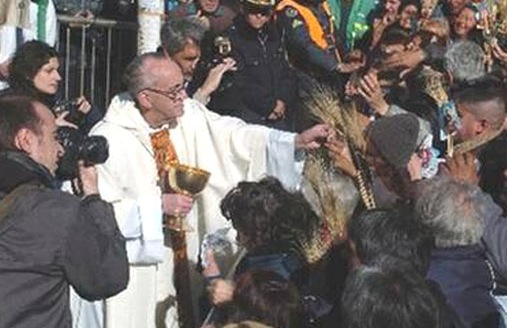
And here is an example of how he offered “Mass”:
When you then hear this jester say that we need to rediscover a “sense of the sacred”, you know what it’s really worth.
Image sources: youtube.com (screenshot) / youtube.com (screenshot) / vatican.va (© Osservatore Romano) / own creation / twitter.com (screenshot) / youtube.com (screenshots) / traditioninaction.org
Licenses: Fair use

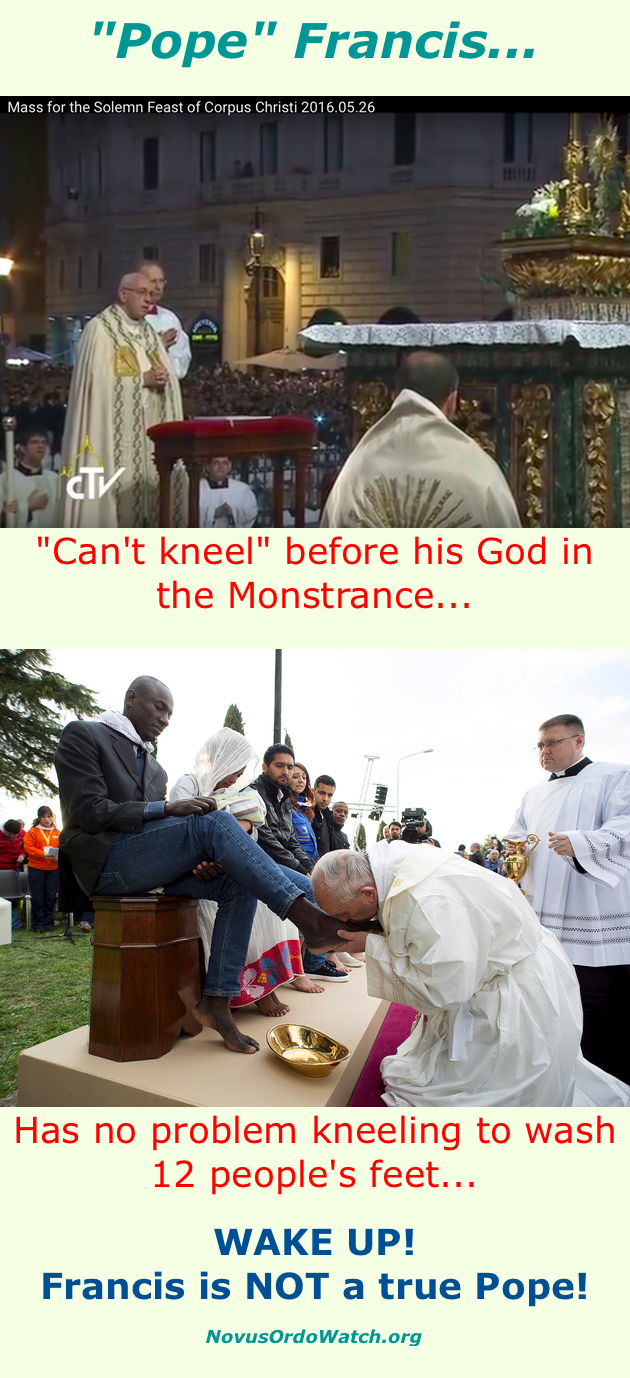
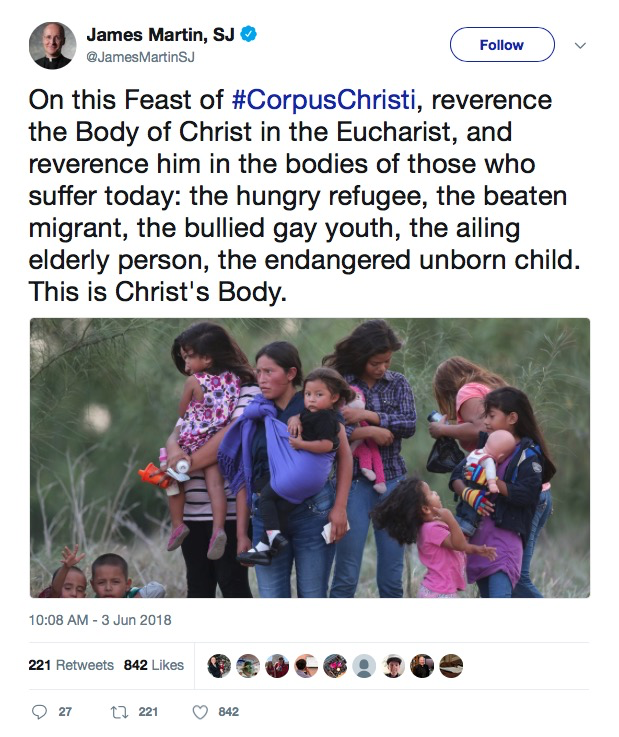



No Comments
Be the first to start a conversation